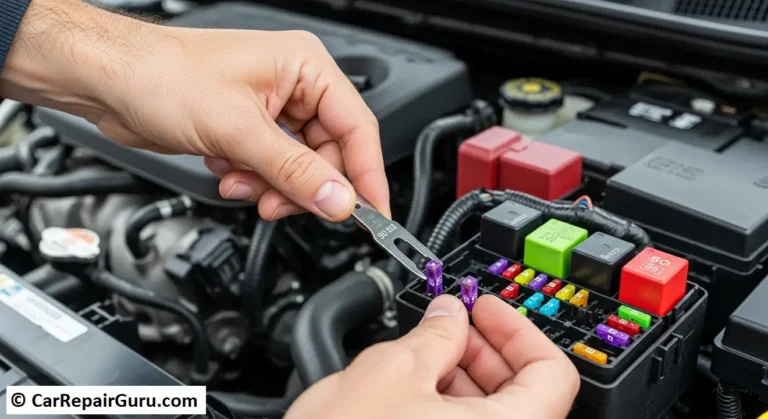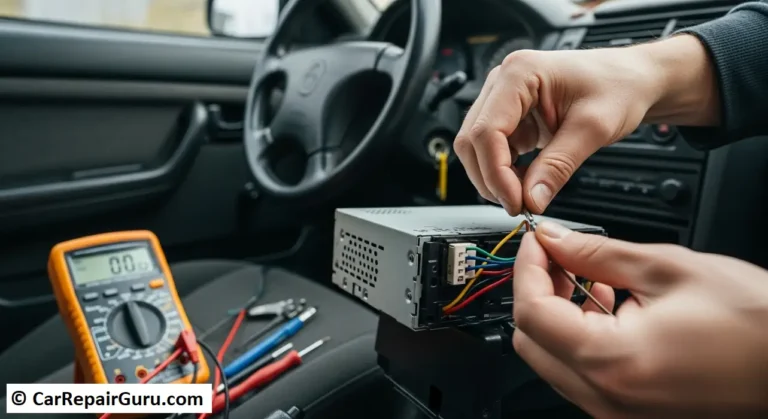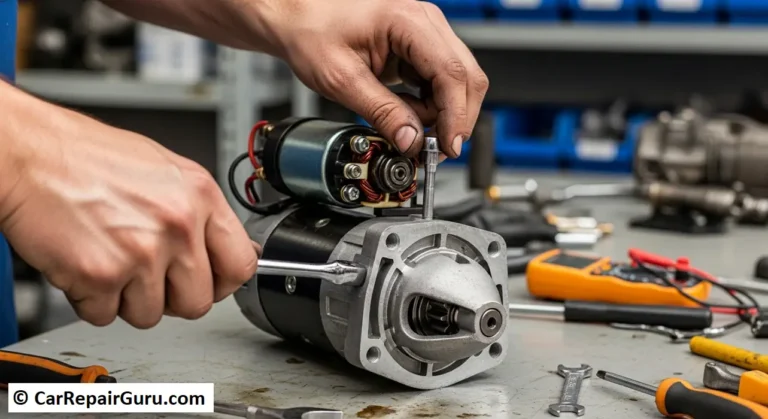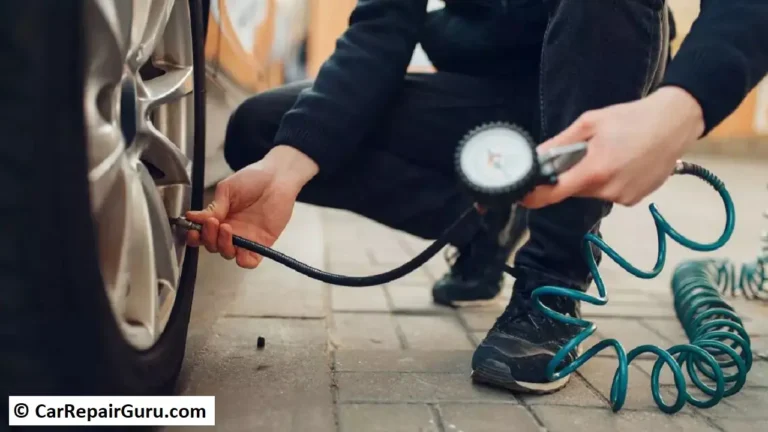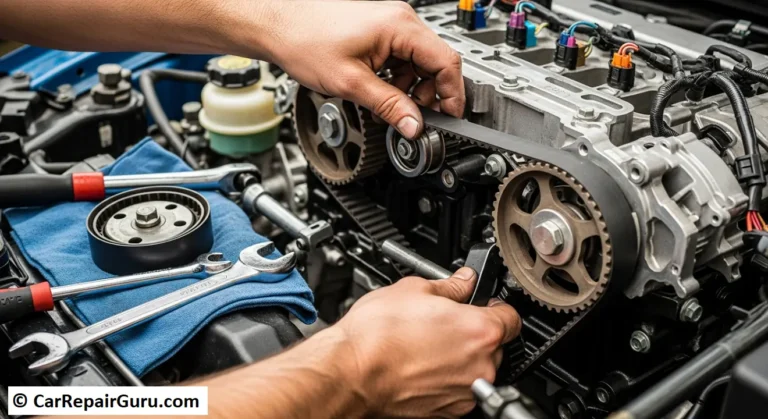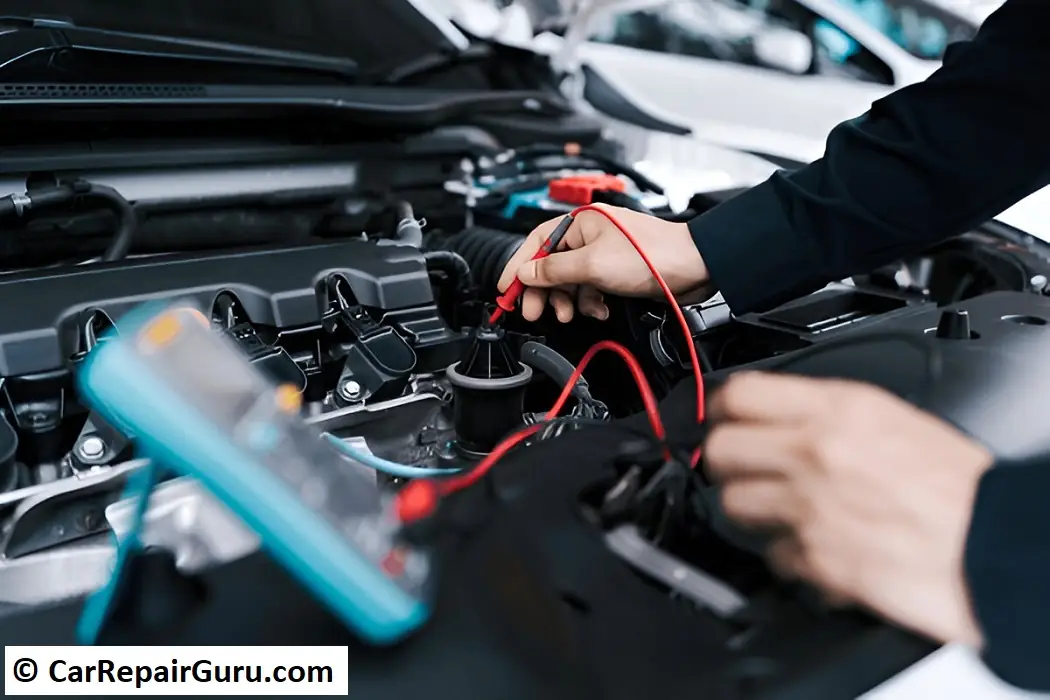
When you turn on your car, dozens of electrical processes power up to bring the vehicle to life. From the headlights illuminating the road to the engine starting with a single turn of the key (or press of a button), the car’s electrical system is the invisible force behind it all.
In this car electrical system guide, we’ll unravel the mysteries of this vital system. Whether you’re a car enthusiast wanting to understand how things work or a driver looking to troubleshoot a pesky electrical issue, this guide is here to help.
With today’s vehicles becoming more reliant on advanced electronics, having a grasp of the basics is more important than ever. This guide explains how the electrical system works, its key components, common issues you might encounter, and practical maintenance tips to keep your car running smoothly.
By the end, you’ll have a clear picture of your car’s electrical foundation and be better equipped to tackle minor problems or know when it’s time to call in the experts.
Key Components of a Car’s Electrical System
Your car’s electrical system is a symphony of interconnected components, each playing a vital role in ensuring your vehicle runs efficiently. Let’s explore the essential parts and how they contribute to the system’s functionality.
Battery
The battery is the heart of your car’s electrical system. It provides the necessary power to start the engine and supports various electrical functions when the engine is off.
- Function: Stores and supplies electrical energy to start the car and run accessories like lights and the radio.
- Types:
- Lead-Acid Batteries (most common).
- Absorbed Glass Mat (AGM) Batteries for advanced systems.
- Lithium-Ion Batteries in electric vehicles.
- Maintenance Tips:
- Regularly clean battery terminals to prevent corrosion.
- Check the charge level using a multimeter.
- Avoid draining the battery by turning off lights and accessories when the engine isn’t running.
Alternator
Once your engine is running, the alternator takes over from the battery to power the car’s electrical components.
- Function: Converts mechanical energy into electrical energy to charge the battery and supply power to systems like lights, air conditioning, and the radio.
- Common Issues:
- Dim headlights or dashboard warning lights signal alternator trouble.
- A squealing noise could indicate a loose alternator belt.
Starter Motor
The starter motor kicks off the engine’s combustion process. Without it, your car wouldn’t start.
- Function: Uses electrical power from the battery to spin the engine’s flywheel, initiating the ignition process.
- Troubleshooting Failure:
- Clicking sounds or a no-start condition often point to starter issues.
- Ensure battery and connections are in good shape before replacing the starter.
Ignition System
This system ignites the air-fuel mixture in the engine, ensuring smooth operation.
- Components: Spark plugs, ignition coils, and control modules.
- Role: Spark plugs generate the spark needed to ignite fuel, while coils amplify the battery’s voltage to power the plugs.
Wiring and Connectors
The wiring system acts as the nervous system, transmitting electrical power and signals throughout the car.
- Significance: A well-maintained wiring harness ensures smooth operation of all electrical components.
- Prevention Tips:
- Inspect wiring for cracks or damage.
- Secure connections to prevent short circuits.
Fuses and Relays
Fuses and relays are the guardians of your car’s electrical system, protecting it from damage.
- Function:
- Fuses protect circuits from overheating and overloading.
- Relays act as switches, controlling high-current components like headlights.
- Tips: Replace blown fuses with ones of the correct rating and inspect relays regularly.
Each of these components plays a critical role in ensuring your car’s electrical system runs seamlessly. A problem in one can lead to broader issues, so regular maintenance and awareness are key. Let’s keep exploring how these parts work together in the next section!
How the Car Electrical System Works
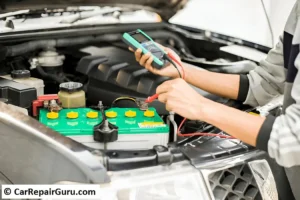
The car electrical system operates like a finely tuned network, delivering power where it’s needed to ensure the vehicle functions seamlessly. Understanding the flow of electricity through this system can help demystify its operation and pinpoint issues when they arise.
The Electrical Flow
The process begins with the battery, which acts as the power source. When you turn the key or press the ignition button:
- Starter Motor Activation: The battery sends a surge of power to the starter motor, which cranks the engine.
- Ignition System: Simultaneously, the ignition system receives power, creating the spark needed to ignite the fuel-air mixture in the engine cylinders.
Once the engine is running, the alternator takes over:
- It generates electrical energy to recharge the battery and supply power to components like the headlights, radio, and air conditioning.
- The alternator converts mechanical energy from the engine’s crankshaft into electrical energy through a process called electromagnetic induction.
The fuses and relays ensure power is distributed safely to various systems, protecting circuits from overloads and controlling high-power devices.
Grounding Process and Continuity
A crucial element of the car’s electrical system is its grounding network.
- What It Does: Grounding provides a return path for electrical currents, completing the circuit and allowing electricity to flow smoothly.
- Why It Matters: Without proper grounding, electrical components may malfunction or fail entirely.
- Maintenance Tips: Check ground wires for rust, corrosion, or loose connections, as these can disrupt continuity.
The entire system relies on a delicate balance of power flow and grounding. Any interruptions—like a damaged wire, weak battery, or faulty alternator—can lead to cascading problems, affecting the car’s performance and reliability.
This foundational knowledge equips you to better understand how the components work together, ensuring your car stays powered and ready for the road!
Common Electrical Issues and Troubleshooting
Car electrical problems are among the most frustrating issues a driver can face. Whether it’s a car that won’t start or flickering lights, understanding the common culprits and their fixes can save you time and money.
Battery Problems
The battery is often the first component to check when electrical issues arise.
- Symptoms:
- The car won’t start, and you hear a clicking noise.
- Dim interior or dashboard lights when the engine is off.
- Troubleshooting Tips:
- Use a multimeter to test the battery voltage; it should read around 12.6 volts when fully charged.
- Look for corroded terminals or loose connections. Cleaning the terminals with a wire brush can often restore functionality.
- If the battery is old (3–5 years), it may be time for a replacement.
Alternator Failures
The alternator is responsible for charging the battery and supplying power to electrical components.
- Symptoms:
- Dim or flickering headlights while driving.
- A warning light on the dashboard (usually shaped like a battery or labeled “ALT”).
- A dead battery despite recent charging.
- Troubleshooting Tips:
- Test the alternator output with a multimeter. A healthy alternator should produce 13.5–14.5 volts while the engine is running.
- Inspect the alternator belt for wear or looseness, as a slipping belt can reduce charging efficiency.
Starter Motor Issues
If your car doesn’t crank when you turn the key, the starter motor could be to blame.
- Symptoms:
- A single click or no sound when attempting to start the car.
- Troubleshooting Tips:
- Check the battery first, as a weak battery can mimic starter issues.
- Inspect wiring to the starter for damage or loose connections.
- If the starter motor is the issue, replacement is often necessary.
Wiring Problems
Damaged or faulty wiring can cause a range of electrical issues, from malfunctioning accessories to starting problems.
- Symptoms:
- Non-functional lights or accessories.
- Burning smell or visible damage to wires.
- Troubleshooting Tips:
- Inspect wires for cracks, fraying, or corrosion.
- Replace damaged wires or connectors and secure loose connections.
- Use a wiring diagram to ensure correct reconnections.
By diagnosing these common issues, you can keep your car’s electrical system in top shape and avoid unexpected breakdowns. If problems persist, consulting a professional is the best course of action.
Maintenance Tips for Car Electrical Systems
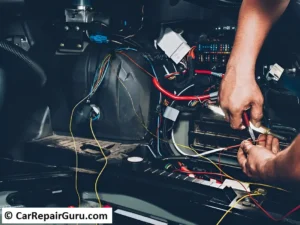
Proper maintenance of your car’s electrical system ensures reliable performance and extends the life of critical components. Here are some practical tips to keep your system in excellent shape:
1. Clean Battery Terminals
Over time, battery terminals can accumulate corrosion, which disrupts the electrical connection.
- Steps:
- Turn off the car and disconnect the battery, starting with the negative terminal.
- Use a wire brush and a baking soda-water mixture to scrub away corrosion.
- Rinse with water and dry thoroughly before reconnecting the terminals.
- Regular cleaning ensures a strong connection between the battery and cables.
2. Check for Corrosion
Corrosion can occur on battery terminals, wiring, and connectors, leading to electrical failures.
- Inspection Tips:
- Look for white, green, or bluish buildup on terminals or connectors.
- Treat minor corrosion with a contact cleaner or dielectric grease to prevent further damage.
3. Inspect Fuses and Relays
Fuses protect electrical circuits from overload, and a blown fuse can disable critical functions.
- Steps:
- Use a fuse tester to check if a fuse is blown. Replace it with one of the same amperage.
- Inspect relays for damage and ensure they are securely seated in the fuse box.
4. Diagnose Wiring Issues
Wiring problems can cause intermittent faults and electrical shorts.
- Tools: Use a multimeter to test continuity and voltage in circuits.
- Tips: Refer to your car’s wiring diagram to trace issues systematically and avoid damaging connected components.
Regularly maintaining your car’s electrical system not only improves performance but also reduces the risk of costly repairs. Invest in basic tools like a multimeter and fuse tester, and don’t hesitate to seek professional help for complex issues. These steps ensure a smooth and dependable driving experience!
Safety Precautions When Working with Car Electrical Systems
Working with your car’s electrical system requires caution to prevent accidents and damage. Following these essential safety tips will help ensure your work is safe and effective.
1. Always Disconnect the Car Battery
Before starting any work on your car’s electrical system, disconnect the battery to eliminate the risk of electric shock or accidental short circuits.
- Steps:
- Turn off the engine and all electrical systems.
- Disconnect the negative terminal first, followed by the positive terminal.
- Secure the terminals to prevent accidental reconnection.
- Reconnecting the battery should always be done in reverse order: positive first, then negative.
2. Avoid Contact with Live Wires
Never touch exposed wires or terminals while the system is powered, as this can result in electric shock or component damage.
- Use insulated tools to handle electrical components safely.
- Test for voltage using a multimeter before touching any wires.
3. Work on a Grounded System
Ungrounded systems can cause electrical faults or injuries.
- Ensure the car is parked on a flat, non-conductive surface.
- Wear rubber-soled shoes and gloves to minimize the risk of electric shock.
4. Follow Manufacturer Guidelines
Always consult your car’s service manual for specific safety precautions related to its electrical system.
By following these precautions, you can safely troubleshoot and maintain your car’s electrical system without endangering yourself or your vehicle.
Advancements in Automotive Electrical Systems
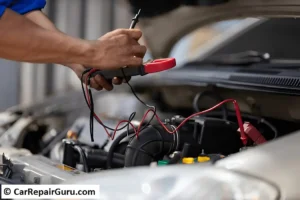
The automotive industry is undergoing a technological revolution, with significant advancements in electrical systems transforming how vehicles operate. Hybrid and electric vehicle (EV) technologies, coupled with cutting-edge electronics, are at the forefront of this evolution.
Hybrid and Electric Vehicle Technologies
Hybrid and electric vehicles rely heavily on advanced electrical systems to deliver performance, efficiency, and sustainability.
- Electric Vehicles (EVs): Powered entirely by high-capacity lithium-ion batteries, EVs eliminate the need for internal combustion engines. Advanced systems manage charging, regenerative braking, and energy distribution to maximize range.
- Hybrid Vehicles: Combine internal combustion engines with electric motors. These vehicles use sophisticated control systems to switch seamlessly between power sources, optimizing fuel efficiency and reducing emissions.
Emerging Innovations in Modern Car Electronics
Modern vehicles are increasingly equipped with intelligent electrical systems to enhance safety, connectivity, and convenience.
- Advanced Driver Assistance Systems (ADAS): Features like adaptive cruise control, lane-keeping assist, and automated emergency braking rely on sensors, cameras, and electrical networks.
- Smart Connectivity: Infotainment systems and wireless communication enable real-time navigation, vehicle diagnostics, and seamless integration with smart devices.
- Energy Management: Innovations like solar roofs and bi-directional charging allow vehicles to both store and share energy efficiently.
As automotive electrical systems evolve, they are paving the way for safer, smarter, and greener transportation, setting new standards for the driving experience.
Conclusion
Understanding and maintaining your car’s electrical system is vital for ensuring its reliability and performance. From powering essential functions to enhancing your driving experience, the electrical system plays a critical role in modern vehicles. Regular inspections, prompt troubleshooting, and consulting professionals for complex issues can save you time and costly repairs. With proper care, you can enjoy a safer, more dependable ride.
FAQ Section
Q1: What are the signs of a failing car electrical system?
A: Common signs of a failing car electrical system include dim or flickering headlights, unresponsive electronics, a dead battery, trouble starting the car, or dashboard warning lights indicating electrical issues.
Q2: How can I maintain my car’s electrical system?
A: To maintain your car’s electrical system, regularly clean the battery terminals to prevent corrosion, check the alternator output to ensure it’s charging properly, inspect wiring for wear or damage, and replace blown fuses promptly to prevent circuit overloads.
Q3: What is the most common cause of car electrical problems?
A: The most common causes of car electrical problems include a weak or dead battery, issues with the alternator, or damaged wiring and connectors that affect the system’s overall functionality.
Q4: Can I fix car electrical problems myself?
A: Basic electrical problems, such as replacing a dead battery, changing fuses, or cleaning battery terminals, can be done at home. However, for more complex issues like faulty wiring or alternator problems, it is recommended to consult a professional mechanic to avoid further damage.
Q5: What tools are needed to work on car electrical systems?
A: To work on car electrical systems, you will need a multimeter to test voltage and continuity, wire strippers for repairing or replacing wires, a fuse tester to check for blown fuses, and basic hand tools like screwdrivers and pliers for general repairs.
